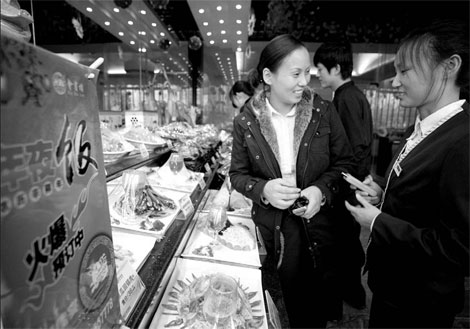Changing face of festival
|
A woman selects dishes for the lunar new year's eve dinner while reserving a table at Huibinlou Hotel in Taizhou, Jiangsu province, on Nov 23, 2010. Gu Jun / Xinhua |
Spring Festival celebrations nowadays are more about convenience than tradition, Shan Juan reports
Many things have changed in Chinese society in the last three decades, thanks to China's unprecedented economic growth. Changes have also taken place in the way Chinese celebrate festivals and the food that is served on such occasions. And that includes Spring Festival, by far the most important festival for Chinese people.
The festival, equivalent to Christmas in the West, begins on the first day of the first month on the Chinese lunar calendar and ends traditionally on the 15th day, known as Lantern Festival.
Apart from the signature festive elements, from cultural activities such as dragon/lion dance and fireworks to decorations like new year couplets (auspicious sayings written on red paper) and red paper cuttings, the food eaten during Spring Festival is the most important. Traditionally, the festival has revolved around the family dinner.
Festive delicacies served during Spring Festival differ in North and South China. Dumplings, or jiaozi, are a must for people in northern China, while people in the southern part prefer niangao, sweet steamed glutinous rice pudding.
Jiaozi, the crescent-shaped dumpling, dates from AD 500. The tradition of eating jiaozi continued in South and North China for hundreds of years before southerners switched to niangao, because rice is the staple in the southern parts.
In some places, people use sugar instead of meat as the filling for jiaozi, hoping that the new year would be as sweet as sugar. Others use a few coins at random with the filling. They believe that the person who gets a jiaozi with a coin will enjoy good luck throughout the year.
Among the other traditional dishes seen on dining tables across the country during the festival are whole fish, signifying abundance and togetherness, and whole chickens, symbolizing prosperity.
In South China, where people follow traditions more strictly, part of the whole fish served at the new year's eve family reunion dinner is left uneaten. It is served for the next meal - the first meal of the new year - because many people believe that by doing so they will get enough food during the coming year.
People in some places in South China also serve other special dishes at the new year's eve dinner, which include dry oyster and fat choy, a terrestrial cyanobacterium that looks like human hair and symbolizes wealth and fortune, and pigs' feet that many believe will bring sudden gains.
But except for the traditional family reunion, Spring Festival celebrations have undergone drastic changes since China introduced the reform and opening-up policy in the late 1970s. The decades-old diary of 87-year-old Li Lianju, a resident of Tieling city in Liaoning province reflects these changes vividly.
The entry on new year's eve on Jan 27, 1960, reads: "We are quite happy that each family member has got two meat dumplings at the dinner. Meat and refined flour are rare because of the great Chinese famine (which began in 1958 and lasted till 1961)."
The entry on new year's eve in 1984 says the food served is much better than what was available in the 1960s and 1970s, and that there are enough dumplings and dishes made of fish and eggs. But fruits like oranges and apples were still rarely seen in the market.
The entry in the diary in 2000, reads: "Life has improved substantially over the years and a great variety of food can be seen on the tables of all families. Since good food is available round the year, we have prepared just four dishes for new year's eve dinner . But it (Spring Festival) is still the most coveted time of the year because everyone tries their best to return home for the family reunion."
Professor Zhang Yongmei, of Lanzhou University in Gansu province, says the content and form of family reunion dinner during Spring Festival has changed with the passage of time. "The essence of the occasion remains the family get-together no matter what is served for dinner and where it is held."
In the past, housewives in almost all Chinese families would work late into the night preparing dishes for the big family reunion feast. Nowadays, many people choose to dine out because they have the money to do so and find it more convenient.
To get a table at a popular restaurant for a Spring Festival dinner, one may have to book months in advance.
Many of the restaurants that used to be closed during Spring Festival before the 1990s now keep their doors open, because new year's eve dinners are big business. Few can ignore the lure of the lucre. Many restaurants even offer guests to choose between an early evening and a late evening dinner.
People are sifting family reunion dinners from home to restaurants, and selecting healthy dishes like seafood and vegetables instead of gorging on food rich in fat. These changes reflect the increasing prosperity in the country, Zhang says.
(China Daily 02/02/2011 page9)



















